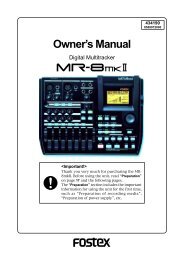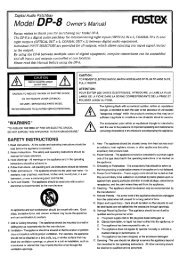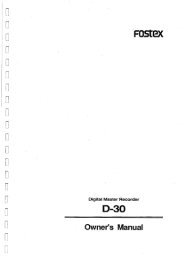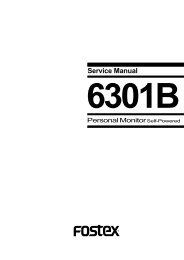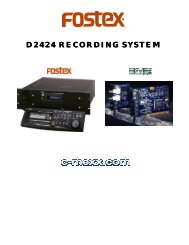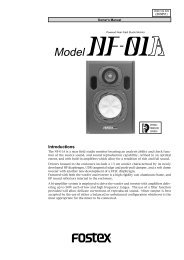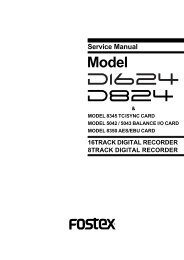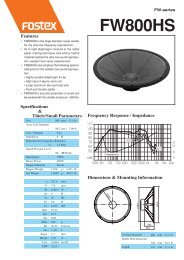audio file in the INSERT mode - Fostex
audio file in the INSERT mode - Fostex
audio file in the INSERT mode - Fostex
You also want an ePaper? Increase the reach of your titles
YUMPU automatically turns print PDFs into web optimized ePapers that Google loves.
Stor<strong>in</strong>g a time to an edit po<strong>in</strong>t memory<br />
The follow<strong>in</strong>g describes how to store a time to an edit po<strong>in</strong>t memory required for track edit<strong>in</strong>g.<br />
There are two methods for enter a time; "on <strong>the</strong> fly" and "numerical entry".<br />
<br />
• If you want to store a time based on LTC <strong>in</strong>stead of ABS time, select <strong>the</strong> displayed time to LTC us<strong>in</strong>g <strong>the</strong><br />
[DISP TIME] key <strong>in</strong> advance.<br />
• Edit po<strong>in</strong>t memories can be used by all <strong>audio</strong> <strong>file</strong>s, however, turn<strong>in</strong>g off <strong>the</strong> power clears all <strong>the</strong><br />
memories and resets <strong>the</strong>m to <strong>the</strong> <strong>in</strong>itial value (00H 00M 00S 00F 00SF).<br />
• Captur<strong>in</strong>g a time "on <strong>the</strong> fly"<br />
Dur<strong>in</strong>g playback, you can capture a time at <strong>the</strong> desired po<strong>in</strong>t "on <strong>the</strong> fly" and store it to an edit po<strong>in</strong>t<br />
memory.<br />
1. Press <strong>the</strong> [PLAY] key to start playback.<br />
2. Press <strong>the</strong> [STORE] key at <strong>the</strong> po<strong>in</strong>t you want to capture <strong>the</strong> time.<br />
The time data at <strong>the</strong> po<strong>in</strong>t when press<strong>in</strong>g <strong>the</strong> key is held and <strong>the</strong> display shows someth<strong>in</strong>g like <strong>the</strong> example<br />
below. To store <strong>the</strong> time to any of <strong>the</strong> edit po<strong>in</strong>t memories, ignore <strong>the</strong> display and go to step 3.<br />
"CUE" or "MEMORY" is lit.<br />
CUE<br />
1<br />
2<br />
ABS<br />
H M S F SF<br />
NEXT<br />
BIT<br />
FS<br />
kHz<br />
-0.1%<br />
FORMAT<br />
BWF<br />
∞ 60 50 42 34 28 2018 12 8 6 5 4 3 2 1 0 OL<br />
48<br />
24<br />
CLOCK<br />
-INT-<br />
Flash<strong>in</strong>g<br />
Tips:<br />
The display example shown above is used to select a memory when stor<strong>in</strong>g <strong>the</strong> time to a locate po<strong>in</strong>t<br />
memory, which will be described later. To store <strong>the</strong> time to any of <strong>the</strong> edit po<strong>in</strong>t memories, ignore this<br />
display and go to step 3.<br />
Tips:<br />
In <strong>the</strong> above step, if you press <strong>the</strong> [STORE] key when <strong>the</strong><br />
[SHIFT] <strong>in</strong>dicator is lit, <strong>the</strong> current time is held and <strong>the</strong><br />
H M S F SF<br />
ABS<br />
MEMORY<br />
subframe digit flashes. In this condition, you can edit <strong>the</strong><br />
value before stor<strong>in</strong>g <strong>the</strong> data. Use <strong>the</strong> [CURSOR/SKIP] || keys to move <strong>the</strong> flash<strong>in</strong>g digit and use <strong>the</strong> jog dial to<br />
enter <strong>the</strong> value. (Or you can directly enter <strong>the</strong> time data us<strong>in</strong>g <strong>the</strong> numeric keys.)<br />
To store edited data, press <strong>the</strong> [STORE] key aga<strong>in</strong>, followed by a desired edit po<strong>in</strong>t key.<br />
3. Press a desired edit po<strong>in</strong>t key ([SOURCE IN], [SOURCE OUT], [DEST IN] or [DEST OUT]).<br />
The time data held is stored to <strong>the</strong> appropriate edit po<strong>in</strong>t memory. The display returns to <strong>the</strong> previous screen<br />
and <strong>the</strong> unit resumes playback.<br />
<br />
You must always set an IN po<strong>in</strong>t earlier than <strong>the</strong> correspond<strong>in</strong>g OUT po<strong>in</strong>t. (i.e. SOURCE IN < SOURCE<br />
OUT, DEST IN < DEST OUT)<br />
4. To store ano<strong>the</strong>r edit po<strong>in</strong>t time, repeat steps 2 and 3 above.<br />
5. After complet<strong>in</strong>g data entry, press <strong>the</strong> [STOP] key to stop playback.<br />
Tips:<br />
To check <strong>the</strong> edit po<strong>in</strong>t time stored, press <strong>the</strong> desired edit po<strong>in</strong>t key while stopped. The time data is<br />
shown on <strong>the</strong> display.<br />
The edit po<strong>in</strong>t memories are used for <strong>the</strong> <strong>audio</strong> data edit<strong>in</strong>g (such as copy, paste, <strong>in</strong>sert, erase and cut)<br />
and <strong>the</strong> direct locate function. See "Chapter 10: Edit<strong>in</strong>g <strong>audio</strong> data" for details.<br />
6-3



